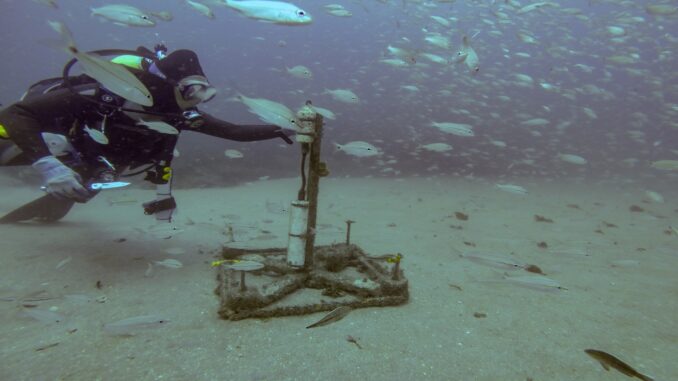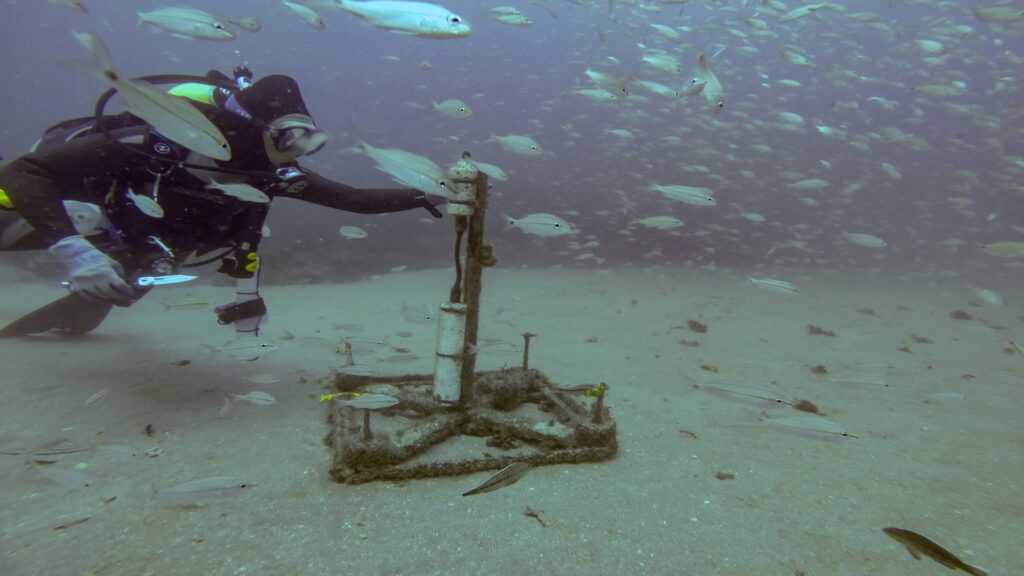
Diving into Sound: A Guide to Underwater Audio Recording
The ocean depths hold a captivating soundscape – the haunting calls of whales, the clicks and whistles of dolphins, the rhythmic rasp of crustaceans. Capturing these sounds allows us to study marine life, understand underwater environments, and create immersive audio experiences. But how do you record underwater audio? While it may seem like a daunting task, with the right equipment and techniques, anyone can become an underwater audio explorer.

A Guide to Underwater Audio Recording
Essential Gear:
- Hydrophone: Forget your standard microphone! Underwater recording requires a hydrophone, a specialized microphone designed to convert sound waves traveling through water into electrical signals.
- Recorder: Pair your hydrophone with a dedicated audio recorder. This recorder needs to be compatible with the hydrophone’s output and have features like waterproofing and gain control. Portable recorders are ideal for field work.
- Cabling: Connecting your hydrophone to the recorder necessitates a waterproof cable. Choose a cable length that suits your recording needs, considering the depth and distance between the hydrophone and recorder.
- Housing: To protect the hydrophone from water pressure and currents, consider using a housing. These come in various materials and designs, with options for tethered or autonomous deployment.
Choosing the Right Hydrophone:
There are two main types of hydrophones to consider:
- Omnidirectional: These microphones capture sound equally from all directions, painting a complete picture of the underwater soundscape. They are ideal for recording ambient noise or calls from unknown locations.
- Directional: These hydrophones focus on sound from a specific direction, allowing researchers to isolate the calls of specific animals. Directional hydrophones are particularly useful for studying vocalizing marine life like whales and dolphins.
Setting Up for Success:
- Preparation is Key: Before venturing underwater, test your equipment on land to ensure everything functions properly. Check connections, audio levels, and waterproofing of the housing.
- Deployment Strategies: The deployment method depends on your recording goals. For stationary recordings, you can lower the hydrophone in a weighted housing. For mobile recordings, consider attaching the hydrophone to a boat or deploying it from an autonomous underwater vehicle (AUV).
- Minimize Noise Interference: Ocean currents and wave action can generate unwanted noise. Experiment with different deployment depths and locations to find areas with less background noise. You can also use a windscreen or a noise-reduction sleeve around the hydrophone for additional protection.
- Recording Techniques: Adjust your recording settings based on your target sounds. For vocalizations, use a higher sample rate to capture the full detail. For ambient soundscapes, a lower sample rate might suffice. Monitor your audio levels to avoid clipping, which distorts the sound.
Safety First:
Always prioritize safety when recording underwater. Be aware of currents, weather conditions, and marine life in the area. Follow proper diving or boating practices and never venture underwater alone.
Beyond the Basics
As you gain experience, explore advanced techniques like using multiple hydrophones in an array for better sound localization. Additionally, consider using software applications to analyze and visualize your recordings, extracting valuable information about marine life and the underwater environment.
The History of Underwater Recording: Capturing Sounds from the Deep
The vast expanse of our oceans, once shrouded in mystery, has revealed itself slowly through exploration and scientific research. While much remains unknown, a crucial tool in understanding this underwater world has been the development of underwater recording technology. Capturing the sounds of the deep has unlocked a hidden sonic universe, one teeming with the calls of whales, the clicks of dolphins, and the mysterious groans of volcanic vents. This journey into the history of underwater recording unveils the challenges faced, the techniques employed, and the ever-evolving technology that allows us to listen to the symphony of the sea.
Early Attempts: Diving Bells and Tin Cans
The first recorded attempt to capture underwater sounds occurred in 1826 on Lake Geneva, Switzerland. Physicists Jean-Daniel Colladon and Charles-François Sturm aimed to measure the speed of sound in water. Their rudimentary setup involved a submerged bell struck with a hammer, with the sound relayed to the surface through a long, submerged tube. The time between the visual observation of the hammer strike and the sound reaching the surface provided an estimate of the sound’s speed. While not a true recording, this experiment laid the groundwork for future endeavors.
The first attempt at actually recording underwater sounds came decades later in the late 19th and early 20th centuries. These early efforts were marked by ingenuity and a touch of DIY spirit. Researchers experimented with submerging various contraptions, including tin cans with attached microphones and waterproofed phonograph cylinders. The results of these attempts were likely limited in quality and fidelity, but they demonstrated the burgeoning desire to listen in on the underwater soundscape.
The Rise of Hydrophones: Listening Through Water
A breakthrough came with the development of hydrophones in the early 20th century. These specialized microphones are designed to convert sound waves traveling through water into electrical signals. This conversion is crucial, as sound waves travel much faster and have different properties in water compared to air. Early hydrophones were often cumbersome and limited in their frequency response, but they marked a significant improvement in capturing underwater sounds.
One of the early pioneers in underwater recording was Maurice Ewing, an American geophysicist. In the 1930s, Ewing used hydrophones to study the topography of the ocean floor, a technique known as echolocation. His work paved the way for using hydrophones for other scientific purposes, including the study of marine mammals and underwater acoustics.
World War II: A Catalyst for Innovation
The Second World War served as a catalyst for the rapid development of underwater recording technology. The need to detect enemy submarines necessitated advancements in hydrophone design and recording techniques. This wartime research led to the creation of hydrophone arrays, which consist of multiple hydrophones arranged in a specific pattern. These arrays offer several advantages, such as improved signal-to-noise ratio, allowing for more accurate sound direction and source identification.
From Analog to Digital: A New Era of Clarity
The later half of the 20th century witnessed the transition from analog to digital recording technology. This shift brought significant improvements in sound quality, recording fidelity, and data storage capabilities. Additionally, the invention of magnetic tape recorders provided a more reliable and portable platform for underwater recording compared to bulky phonograph cylinders.
Challenges and Solutions: The Deep Sea Beckons
Underwater recording presents several unique challenges. One major hurdle is the pressure at increasing depths. Standard microphones can be crushed by the immense pressure of the deep ocean. Hydrophones are specifically designed to withstand these pressures, but even they require careful construction and testing.
Another challenge is the constant movement of the water. Ocean currents and wave action can generate unwanted noise that interferes with the desired sounds. Researchers employ various techniques to mitigate this, such as deploying hydrophones in tethered pods with streamlined designs or suspending them in neutrally buoyant housings.
Specialized Microphones for Specific Tasks
The type of underwater microphone used depends on the specific application. For capturing the vocalizations of marine mammals like whales and dolphins, directional hydrophones are often used. These hydrophones offer a narrower field of view, allowing researchers to focus on sounds from a specific direction.
For studying the calls of smaller creatures or recording ambient soundscapes, omnidirectional hydrophones are employed. These microphones capture sound from all directions, providing a more complete picture of the underwater soundscape. Additionally, towed hydrophone arrays are used for seismic surveys and to map the ocean floor.
Unlocking the Secrets of the Deep: Applications of Underwater Recording
Underwater recording finds application in various fields. Marine biologists use recordings to study the communication patterns of marine mammals, understand their movements and behavior, and even monitor their population health. Oceanographers employ recordings to investigate underwater acoustics, understand the effects of human activity on marine animals, and map the ocean environment. Underwater soundscapes can also provide valuable information about the presence of specific fish species, allowing for more sustainable fishing practices.
The Future of Underwater Recording: A Window into the Blue
The future of underwater recording holds immense promise. Advancements in materials science are leading to the development of even more robust and pressure-resistant hydrophones, allowing us to explore the deepest trenches of the ocean. Additionally, the miniaturization of recording devices offers the potential for deploying autonomous underwater vehicles (AUVs) equipped with hydrophones, enabling long-term, remote monitoring of the underwater world.
The integration of artificial intelligence (AI) with underwater recording technology is another exciting prospect. AI algorithms can analyze vast amounts of acoustic data, helping researchers identify specific sounds, track vocalizations over time, and even differentiate between different species based on their calls. This can lead to a deeper understanding of marine life and the complex ecosystems within the oceans.
As technology continues to evolve, underwater recording will undoubtedly play a crucial role in unlocking the many secrets of the deep. The symphonies of the ocean, once shrouded in mystery, are becoming increasingly accessible, providing us with a window into the lives of marine creatures and the delicate balance of the underwater world. By listening to the ocean, we gain a deeper appreciation for its beauty, complexity, and the urgent need for its conservation.
Popular Posts:
Stylophone Tabs
Banjo Tabs
Dulcimer Tabs
Kalimba Tabs
Mandolin Tabs
